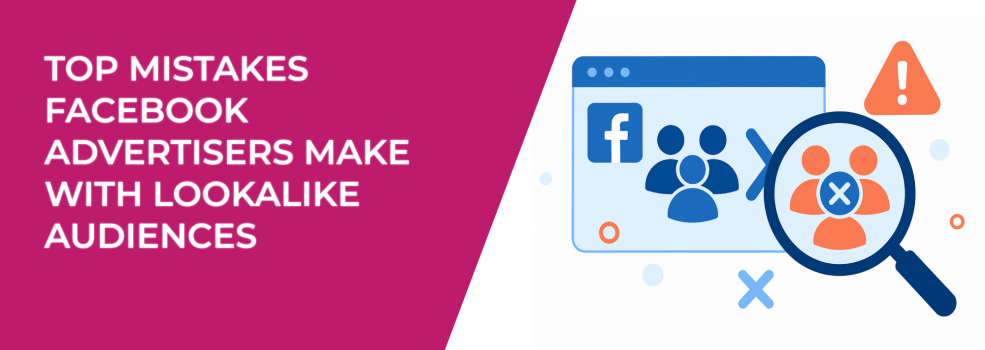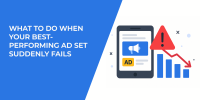Lookalike audiences are one of the most powerful targeting options in Facebook Ads. They allow you to reach new people who share the same behaviors, interests, and purchase intent as your best customers. When set up correctly, they can lower your cost per acquisition (CPA), improve click-through rates (CTR), and help you scale campaigns efficiently.
But here’s the challenge: many advertisers use them incorrectly. The result? Wasted ad budget, irrelevant clicks, and underperforming campaigns.
In this guide, we’ll break down the most common mistakes with Facebook lookalike audiences, explain why they hurt performance, and show you exactly how to fix them.
1. Using Low-Quality Seed Audiences
Your seed audience — also called a source audience — is the foundation of your lookalike. If the quality of that data is poor, your results will be too.
Common mistakes include:
-
Uploading outdated email lists with subscribers who haven’t engaged in years.
-
Using every past customer, including one-time low-value buyers.
-
Creating a seed from mixed-intent leads rather than paying customers.
Why this matters: Facebook’s algorithm uses your seed audience to identify patterns — demographic details, behaviors, and interests. If those patterns are based on disengaged or low-value people, Facebook will match you with more of the same.
How to fix it:
-
Use recent data — ideally from the last 6–12 months.
-
Prioritize high LTV (lifetime value) customers, not just anyone who’s purchased.
-
Aim for at least 500–1,000 people in your seed for accuracy.
Example: If you run an online store for premium home fitness equipment, don’t use your full email list. Instead, create a seed from the top 500 customers who spent $500+ in the last year. That’s the type of audience Facebook can model for better results.
If you’re unsure how to build a high-quality audience foundation before creating lookalikes, our guide on How to Define a Target Audience for Marketing: a Step-by-Step Guide walks you through a proven process.
2. Picking the Wrong Lookalike Size
When creating a lookalike audience, Facebook lets you choose a size from 1% to 10% of the selected country’s population.
-
1% = The top 1% most similar to your seed. Very precise, smaller reach.
-
10% = Much larger reach but less similarity.
Mistake: Some advertisers always choose 1% without testing, limiting reach. Others jump to 10% too soon and lose precision.
Best practice:
-
Start with 1% for high-intent conversion campaigns.
-
Test 2–5% for scaling and brand awareness.
-
Run split tests to find your best-performing size.
Pro tip: Build tiered lookalikes — run separate ad sets for 1%, 3%, and 5%. This way, you can scale gradually and keep an eye on performance changes.
3. Not Updating Lookalikes Regularly
A lookalike audience isn’t a “set it and forget it” tool. Consumer behavior changes, market trends shift, and your best customers today may not be the same six months from now.
Why this hurts performance: If you keep running ads to a lookalike built on outdated data, you risk targeting people who no longer match your ideal customer profile.
How to fix it:
-
Refresh your seed audience at least every 3–6 months.
-
In fast-moving industries (like fashion or tech), update monthly.
-
Rebuild lookalikes with fresh seeds instead of stacking old data on top.
Example: A seasonal apparel store should rebuild its lookalike before launching each seasonal collection, using last season’s top buyers as the seed.
4. Overlapping With Other Targeting
Lookalike audiences often overlap with your other saved audiences — like interest-based targeting or different lookalike sets. This overlap means you’re competing against yourself in the Facebook ad auction, which can drive up costs.
How to fix it:
-
Use Facebook’s Audience Overlap tool to spot duplicates.
-
Exclude remarketing lists from cold lookalike campaigns.
-
Separate targeting by funnel stage:
-
Awareness = Lookalikes.
-
Consideration = Website visitors.
-
Conversion = Past buyers.
-
Why it matters: Keeping your audiences clean and distinct ensures each ad set works toward a specific goal without cannibalizing performance or wasting spend.
For a deeper dive into managing audience overlap and avoiding wasted spend, read The Role of Audience Overlap in Facebook Ads Performance.
5. Serving the Wrong Creative
Lookalike audiences are cold audiences — they’ve never interacted with your brand. Serving them the same creative you use for warm traffic usually fails.
Better approach:
-
Open with a strong hook in the first 3 seconds.
-
Clearly show your main benefit up front.
-
Add social proof (reviews, ratings, media mentions) to build trust.
Example: If your seed is based on high-value B2B clients, show quick video case studies or testimonials rather than a generic product shot. This builds credibility with people who don’t know you yet.
Matching your ad message to audience temperature is critical — see The Psychology of Facebook Ads: How to Hook Your Target Audience in Seconds for inspiration.
6. Using Lookalikes Too Soon
If you don’t have enough high-quality customer data, a lookalike audience won’t be accurate. Running them too early means Facebook is building your audience on incomplete or low-quality signals.
Best practice:
-
First, run campaigns to collect high-quality leads or customers.
-
Build lookalikes only after you have a few hundred strong converters.
-
Use broad or interest targeting early on to train your pixel before scaling.
Why it matters: Waiting until you have solid conversion data allows Facebook’s algorithm to identify patterns more accurately, which means your lookalike audiences will be far more likely to deliver profitable results.
If you’re still building your first-party data, Retargeting vs. Broad Targeting: Which Strategy Drives Better Results? can help you choose the right approach before moving to lookalikes.
7. Not Layering Targeting Filters
A 1% lookalike is already very specific, but a 5–10% lookalike can be too broad to be efficient without extra targeting layers.
You can refine by:
-
Location — limit to your shipping regions or service areas.
-
Purchase behaviors — filter for frequent buyers.
-
Industry-related interests — match niche products to niche audiences.
Warning: Avoid over-layering. Adding too many filters can reduce your reach so much that your ads stop delivering efficiently.
Final Takeaway
Facebook lookalike audiences remain one of the most effective targeting tools in 2025, but they require maintenance and strategy. The advertisers getting consistent results are the ones who:
-
Build seeds from high-quality, recent data.
-
Test audience sizes and tiered targeting.
-
Refresh lookalikes regularly.
-
Match creative to audience temperature.
Run an audit of your current setup. Check your seed quality, lookalike size, and update frequency. Even small adjustments in these areas can lead to significant gains in CTR, conversion rates, and return on ad spend (ROAS).

